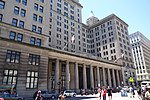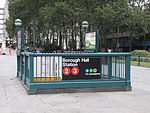Brooklyn Borough Hall
1848 establishments in New York (state)City and town halls on the National Register of Historic Places in New York (state)Downtown BrooklynGovernment buildings completed in 1848Government buildings in Brooklyn ... and 6 more
Government buildings on the National Register of Historic Places in New York CityGovernment of New York CityGreek Revival architecture in New York CityNational Register of Historic Places in BrooklynNew York City Designated Landmarks in BrooklynUse mdy dates from June 2013

Brooklyn Borough Hall is a building in Downtown Brooklyn, New York City. It was designed by architects Calvin Pollard and Gamaliel King in the Greek Revival style, and constructed of Tuckahoe marble under the supervision of superintendent Stephen Haynes. It was completed in 1848 to be used as the City Hall of the former City of Brooklyn. In January 1898 the independent City of Brooklyn merged with the City of New York, and Kings County became the Borough of Brooklyn, at which time the building became Brooklyn Borough Hall.
Excerpt from the Wikipedia article Brooklyn Borough Hall (License: CC BY-SA 3.0, Authors, Images).Brooklyn Borough Hall
Joralemon Street, New York Brooklyn
Geographical coordinates (GPS) Address Phone number Website External links Nearby Places Show on map
Geographical coordinates (GPS)
| Latitude | Longitude |
|---|---|
| N 40.692777777778 ° | E -73.99 ° |
Address
Brooklyn Borough Hall
Joralemon Street 209
11201 New York, Brooklyn
New York, United States
Open on Google Maps







